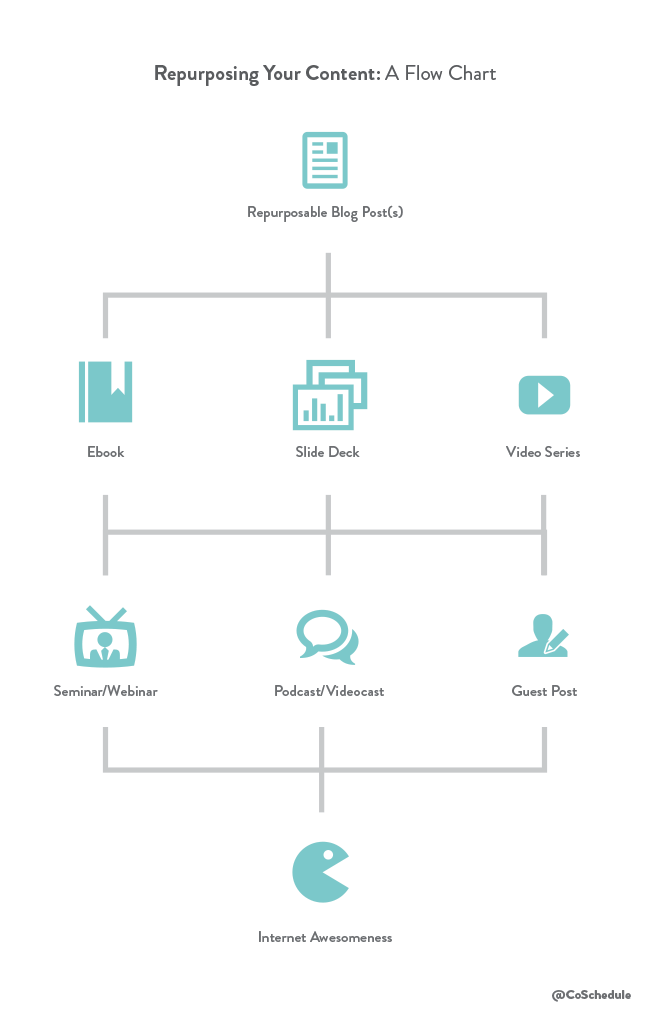By Garrett Moon
Repurposing your content for a new audience may not be at the top of the list for many bloggers, but it ought to be. There is something exciting about the old becoming new again.
In 2012, Karl Kissner of Toledo, Ohio found an old box of baseball cards in his attic. The set, in near mint condition, was later found to include Hall of Famers such as Ty Cobb and Cy Young. After further investigation, the set was valued at over $3 million dollars. Not a bad for a day in the attic. Old cards, new money. Source: Time.com

What about your attic, or specifically, your content history? You probably have some killer content in your attic that could be repurposed for a new audience. Have you ever considered the possibilities?
Repurposing your content for use in another way may not snag you $3 million dollars, but it can dramatically increase your return on investment, and that is what repurposing your content is all about.
Why Repurposing Your Content Is A Good Idea
Content repurposing doesn’t just mean that you reuse an old piece of content again and again. True repurposing requires that we alter it to make it fresh and appealing to a new audience. There are several benefits:
Content repurposing saves time. There’s no question that it takes time to develop good content. By reposing our old content, we save ourselves time rather than constantly developing new ideas and starting from scratch.
Content repurposing can expose your content to a new audience. We’ve previously written about the very subject of content repurposing over on our Todaymade blog, which is a totally different audience than the one here at CoSchedule. By spinning the article in two different directions, we’ve properly reached each audience in a way that works best for them.
Content repurposing increases the return on your original investment. One of the reasons that we are such fans of content marketing is that it has a long-tail return on investment (ROI). By this, I mean that, at minimum, the long-term SEO value of content publishing makes it completely worth while. When we add content repurposing to the mix, we only stand to further this ROI.
Content repurposing further establishes you as a subject matter expert. Write about something once, and you’re a guy who did his homework. Write about it twice, and you’ve become a subject matter expert. One of the primary benefits of good content marketing is to establish you, or your brand, as an authority. When we double-down on key topics, we only stand to further this reputation.
Content repurposing extends the longevity of your work. While every long-time blogger has content from 2008 that still pulls its weight in Google traffic, that isn’t the only way to make your content last. Revisiting or repurposing your content adds longevity to your content that may be long forgotten otherwise.

Many of Todaymade’s free marketing guides began as a single blog post.
How To Go About Repurposing Your Content
One of my favorite strategies for content repurposing is to take a group of old blog posts and refactor them into something new. For example, I was able to turn 10 blog posts into more than $40k in revenue by simply repurposing them into a content training series. The first step in this process is to review your blog history and find the right content themes to highlight. There are a few things to look for:
Key themes that are still relevant. Some of the topics that you write about will become less crucial over time, but others will only increase in intensity. This is probably one of these easiest ways to identify reusable content. Which topics are still sticky, or just as sticky for a new audience?
Topics that stay popular. Research your traffic patterns. Which topics get the most organic attention on your blog? Often the topics that our traffic patterns latch onto are not what we would expect. For example, a post that I found rather boring about Twitter lists got great traffic and attention. So good, in fact, that I later turned that post into a full-blown ebook on Twitter marketing. Use your analytics to make strategic content decisions.
Topics where you have more to say. Things change, and many times we have new things to offer on a topic mere months after publishing. Other times, we just weren’t able to share the full story in one post. Posts that feel incomplete make great targets for repurposing your content.
Once you identified the topic, theme, and actual blog posts that you want to use for repurposing your content, there area few things for you to do. For starters, you’ll need to decide where you will repurpose it to. There are several options.
- An ebook. We’ve turned many of our best blog series into ebooks about writing, social media, and creativity. A good ebook could be hiding anywhere on your blog. Use a tool likePapyrus to make the layout process a snap.
- A presentation or slide deck. With as little as a single post, you can easily turn your content into a Keynote or PowerPoint presentation that is shared online via SlideShare. This makes it easy for other bloggers to embed your content right in their post.
- Video series. Sites like Skillshare and the new Google Helpouts allow you to host a video course all on your own. Consider the possibility of converting a recent blog series into a viral video.
- Training seminar or webinar. Use the content to present to a local meetup group or business seminar. You could even take it online with a free webinar.
- Podcast or video cast. Blog topics make great talking points for podcasts or video blogs. Some audience members will prefer to watch rather than read.
- New blog series. Perhaps you have a single post that could be repurposed into an entire series.
- Guest post topic. I often reach back to some of my past posts when developing new guest posts. Guest posting opportunities expose you to a new audience so this is great place to resurface some of your best stuff. When doing this, it is imperative that you develop new unique content that is only based on your previous ideas.
There is bit more to consider when repurposing your content. For example, what will you need to change about the old content to make for a successful repurposing? It is important to make a list of updates that you will need to make before you get started. What has changed in the industry? Is there new information to be included?
You may find that repurposing one post will take much longer than another because of these type of changes. This may provide a good opportunity to prioritize one over another.
You will also want to consider the angle, or approach, that you want to take on the subject. Is there a fresh way to approach it? A new spin? How can your new content truly revitalize the old?
Maybe your get the jitters when you think about repurposing your content. I get that. There have been many before us that have abused this technique. Almost every blogger has had their content scraped by a spammer. This doesn’t feel very good, and it is definitely not an example of the type of content repurposing that I am talking about. True repurposing should provide more value to your audience, and to you. It needs to be a win-win situation, and not just an easy excuse to republish.
